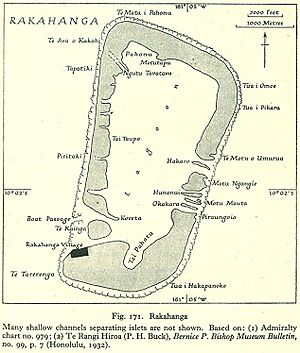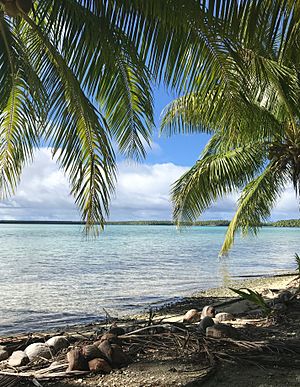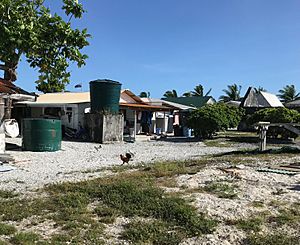Rakahanga facts for kids

NASA picture of Rakahanga
|
|
| Geography | |
|---|---|
| Location | Central-Southern Pacific Ocean |
| Coordinates | 10°02′S 161°05′W / 10.033°S 161.083°W |
| Archipelago | Cook Islands |
| Total islands | 11 |
| Major islands | Rakahanga |
| Area | 4 km2 (1.5 sq mi) |
| Administration | |
| Largest settlement | Rakahanga |
| Demographics | |
| Population | 83 |
| Pop. density | 32 /km2 (83 /sq mi) |
| Ethnic groups | Nu-matua, Tia-ngaro-tonga |
Rakahanga is a beautiful and untouched atoll (a ring-shaped coral island) in the Cook Islands. It's located in the central-southern Pacific Ocean. This special island is about 1,248 kilometers (775 miles) from Rarotonga, the capital of the Cook Islands.
Rakahanga is also about 1,111 kilometers (690 miles) south of the equator. Its closest neighbor is Manihiki, which is only 44 kilometers (27 miles) away. The total land area of Rakahanga is about 4 square kilometers (1.5 square miles). The highest point on the island is only about 5 meters (17 feet) above sea level.
In 2016, the island had a population of 83 people. Since 2014, Rakahanga has been powered completely by solar energy. The local language, Rakahanga-Manihiki language, is a bit different from the main Cook Islands Maori language.
Contents
Rakahanga Island: A Pacific Gem
Geography and Landscape
Rakahanga is made up of four main islands and seven smaller motus (or islets) inside a calm lagoon. The northern island is split into three parts: Tetukono, Tetaha Kiraro, and Paerangi. The southern island is simply called Rakahanga Island.
The smaller motus include Te Motu o Umurua, Akaro, Motu Ngangie, Huananui, Motu Mahuta, and Motu Okakara on the east side. On the southwest side, Te Kainga islet guards the widest entrance to the lagoon. The northeast coast has lovely sandy beaches. The west coast is made of rubble and rock from old reefs. The atoll is covered in many coconut palms.
Rakahanga's lagoon is quite shallow, and the seawater doesn't move around much. This makes it hard for corals to grow well. The natural entrances to the lagoon are narrow and shallow, so only canoes and small boats can get through. Around 2015, a deeper channel was made to improve access.
The main settlement on Rakahanga is on the northwest side of the southern islet. It's made up of five villages that are connected:
- Purapoto
- Niteiri
- Numahanga
- Teruakiore
- Matara (This is the main village and where the Rakahanga Island Council meets.)
Island Climate
Rakahanga has a warm and steady climate. Daily temperatures usually range from about 26°C (79°F) to 31°C (88°F). It's usually dry from May to October. From November to April, it's hot and humid, which is also the cyclone (hurricane) season. However, big storms are quite rare. During La Niña weather patterns, it can be even drier, sometimes leading to water shortages.
A Look at History
Early Maori Settlers
People first settled on Rakahanga around 1350 AD. Stories say the first people were a warrior named Toa and his wife Tapairu. They came from Rarotonga. They settled on the islet of Te Kainga.
Toa and Tapairu had four daughters. Over time, their family grew, and the population increased quickly. The community eventually split into different groups, but there are no stories of wars between them. Te Kainga was the only place people lived on Rakahanga for a long time. They used pearl shells for tools like saws and fishhooks. The rest of the atoll was used to grow food, mostly coconuts, pandanus, and puraka (a type of taro).
Eventually, there wasn't enough food for everyone. So, the whole community started moving between Rakahanga and the nearby island of Manihiki. They would move every few years, letting the vacated island recover its food supply. This was a dangerous journey.
European Visitors
It's thought that Ferdinand Magellan might have seen Rakahanga in 1521, but this isn't certain. The Spanish explorer Pedro Fernandes de Queirós definitely found the island on March 2, 1606. He wrote that the island was covered in palm trees, which were the main food source for the people. He saw about 500 people on the beach and described them as "the most beautiful white and elegant people."
Later, in 1820, Russian explorer Fabian Gottlieb von Bellingshausen visited Rakahanga. He named it "Grand Duke Alexander Island." He noted that the islanders came out in canoes and threw stones and spears at his ship. In 1874, someone wrote that the island's coconut groves were so thick they amazed all sailors who visited.
Missionaries Arrive
In 1849, two missionaries from the London Missionary Society came to Rakahanga. Their goal was to teach people about the Bible in their own language. Within a few years, most people were baptized and given new names. In 1855, a missionary named Maretu decided that the people should live permanently on Rakahanga and Manihiki separately. This was to prevent loss of life during the dangerous ocean trips between the islands. Maretu also asked that the main village be moved to its current location to be more organized.
The missionaries set up schools to teach reading and writing using an alphabet they created for the local language. They also started to control many parts of island life. They stopped traditional games and dances, and people who broke rules were punished.
British Rule and New Zealand Connection
Rakahanga became a British protectorate (meaning it was protected by Britain) in 1889. This didn't change much for the islanders at first.
In 1901, Rakahanga and other islands became part of New Zealand. The New Zealand government slowly improved things, like building a large concrete water tank in 1912 and a Courthouse in 1917. A government school was finally opened in 1951. It taught children up to Year 10, following a New Zealand school plan.
Self-Rule and Modern Times
The Cook Islands became self-governing in 1965. Pupuke Robati was the first person elected to represent Rakahanga. He even became Prime Minister of the Cook Islands for a short time in 1987. His daughter, Tina Browne, is now a political leader.
In 2014, Rakahanga got 100% solar-generated power with help from the EU and New Zealand. New roofs, gutters, and water tanks were also installed on houses. Mobile phone service was added in 2007 and improved in 2013.
The United States once claimed Rakahanga under the Guano Islands Act, but they gave up this claim in a treaty with the Cook Islands in 1980.
Plants and Animals
Rakahanga is a nesting place for green sea turtles. Coconut crabs are protected, and people can only collect them during certain times of the year. The outer reef is a great place for fishing. Every January, there's a tuna fishing contest.
You can also see white terns nesting along the lagoon. Frigate birds and brown boobies are common seabirds. Unfortunately, feral cats and rats were brought to the island by Europeans. Pigs and chickens are farmed, and some also live in the wild. Dogs are not allowed on the atoll.
Native ngangie and toa trees grow all over the islets. However, coconut palm trees are the most common. Large breadfruit trees line the village paths, and pandanus trees grow well.
People and Culture
Island Religions
Before missionaries arrived, Polynesians believed gods had physical forms. Over time, new gods were brought to Rakahanga. People built special paved areas called maraes for religious gatherings.
In 1849, the London Missionary Society (LMS) arrived. Many people converted to Christianity. A large church was built from coral rock. The LMS name was changed to the Cook Islands Christian Church around 1960. This big white church is still the most important building on the atoll, and most people attend services there.
The Roman Catholic religion came to Rakahanga in 1926. A church and school were built. By 1935, about a third of the people were Catholic. However, after priests left, many people returned to the Cook Islands Christian Church or became Seventh Day Adventists.
In 2018, about a quarter of the population were Seventh Day Adventists.
Population Changes
| Historical population | ||
|---|---|---|
| Year | Pop. | ±% |
| 1906 | 352 | — |
| 1916 | 295 | −16.2% |
| 1926 | 327 | +10.8% |
| 1936 | 290 | −11.3% |
| 1951 | 261 | −10.0% |
| 1961 | 319 | +22.2% |
| 1966 | 323 | +1.3% |
| 1976 | 283 | −12.4% |
| 1986 | 282 | −0.4% |
| 1996 | 249 | −11.7% |
| 2001 | 169 | −32.1% |
| 2006 | 141 | −16.6% |
| 2011 | 77 | −45.4% |
| 2016 | 83 | +7.8% |
| Source: | ||
When missionaries arrived in 1849, between 800 and 1200 people lived on Rakahanga and Manihiki. Rakahanga had about 400 residents until 1901. The population decreased in 1916 because people moved to Rarotonga to find jobs. Since the late 1900s, the population has continued to decline as people move to Rarotonga, New Zealand, and Australia.
The number of residents changes as families sometimes move away temporarily. For example, a 2011 survey counted 79 residents, while a 2012 survey counted 102. In 2016, the census counted 83 people. The government school, which opened in 1951, now has fewer than 20 students.
Unique Island Culture
Chants, stories, drumming, and dance were very important to Rakahangan culture. Visitors in the early 1900s said that dancing was the people's "chief reason for existing." They were described as the best singers and dancers in the whole South Pacific.
Traditional double canoes were decorated with beautiful pearl shell inlays. The Cook Islands Christian Church has many examples of this fine inlay work on furniture.
Island Tribes
Rakahanga is home to two main tribes, the Whakaheo, which are called Matakeinanga and Tukuwhare. Each of these tribes has seven smaller groups, or subtribes:
| Matakeinanga | Tukuwhare |
|---|---|
| Nu-matua |
|
| Tia-ngaro-Tonga |
|
How the Island Makes a Living
Traditional Economy
For a long time, the economy of Rakahanga depended on the coconut palm. Before Europeans arrived, coconut palms were very valuable. Every part of the palm was used for food, building, clothing, fuel, or making baskets and nets.
Modern Economy
When trading ships started visiting, people needed goods to trade. They exchanged pearl shells and copra (dried coconut meat used for coconut oil) for manufactured goods. By the 1890s, European traders lived on Rakahanga, buying copra and selling general items.
However, in the second half of the 1900s, the international market for copra declined, and prices dropped. This made the copra industry on Rakahanga unprofitable. In 2001, 90% of the people who had jobs worked for the government.
Dried fish could be an export product. Also, rito hats, mats, and baskets, woven by women from coconut leaves, are still popular in Rarotongan markets because of their high quality. These are made using old techniques that were famous for producing "highly prized" mats.
There have been attempts to start a pearl industry, but the lagoon's shallow water and poor flow make it difficult. Some Rakahangans benefit from the black pearl industry in Manihiki through ownership or jobs there.
There are no hotels for tourists on Rakahanga, but you can arrange to stay with local families. Getting to the atoll is still very hard. AirRaro offers flights to Manihiki, usually every two weeks. Both Manihiki and Rakahanga communities use outboard motor boats to travel between the atolls, which can take up to 3 hours. Another option is a 3-6 day trip on a trading ship from Rarotonga or Tahiti, but these ships don't run often. An airstrip built on Rakahanga in 1982 was damaged by waves in a cyclone and can no longer be used.
Famous People and Events
Julian Dashwood, a writer, lived on Rakahanga in the mid-1930s. He wrote articles and a novel about his time there.
Rakahanga became famous internationally in 1958 when a raft expedition, similar to the Kon-Tiki, led by Frenchman Éric de Bisschop, crashed on the reef. De Bisschop was killed and first buried on the atoll. Later, a French naval group moved his body to Tahiti for a reburial.
Pupuke Robati was the Prime Minister of the Cook Islands from 1987 to 1989.
See also
 In Spanish: Rakahanga para niños
In Spanish: Rakahanga para niños
- About the island "where tomorrow never comes"
- Rakahanga through a visitor's eyes
- List of Guano Island claims
- Rakahanga (Cook Islands electorate)
- Rakahanga-Manihiki language





